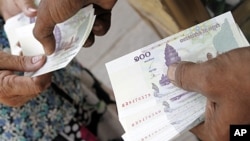PHNOM PENH —
The Asian Development Bank on Tuesday said it expects Cambodia’s economic growth to slow slightly in 2014.
In its annual “Asian Development Outlook,” the bank said it expects to see a drop in the rate from about 7.2 percent last year to 7 percent this year but estimates growth could rebound to about 7.3 percent in 2015.
“Growth in Cambodia is set to ease moderately in 2014, before picking up in 2015 on the back of buoyant exports and robust agriculture and service sectors,” the report says.
Ongoing political tension as well as dipping investor confidence in the manufacturing sector—where workers are demanding higher wages and threatening mass strikes—were behind the predicted slowdown.
Labor unrest has affected the output of the garment industry, and demand for garments and footwear from the US and Europe is projected to decline from 10.5 percent last year to 8.7 percent this year, bank officials said.
Those uncertainties could have effects in tourism, construction and real estate, the bank said.
Inflation is expected to rise up to 3.5 percent this year, in part due to tightening of customs collections, which could increase the price of imports, the report says.
Cambodia’s public debt is an estimated $4.8 billion, 31.7 percent of its GDP, and is expected to increase.
Cambodian economic officials were not immediately available for comment.
Opposition leader Sam Rainsy, formerly Cambodia’s finance minister, said the country is facing worse problems than shrinking growth.
The growth in Cambodia’s economy has not been a good illustration of the reality across the country, he said. “Some studies just look at the surface of what has been happening in Cambodia.”
In its annual “Asian Development Outlook,” the bank said it expects to see a drop in the rate from about 7.2 percent last year to 7 percent this year but estimates growth could rebound to about 7.3 percent in 2015.
“Growth in Cambodia is set to ease moderately in 2014, before picking up in 2015 on the back of buoyant exports and robust agriculture and service sectors,” the report says.
Ongoing political tension as well as dipping investor confidence in the manufacturing sector—where workers are demanding higher wages and threatening mass strikes—were behind the predicted slowdown.
Labor unrest has affected the output of the garment industry, and demand for garments and footwear from the US and Europe is projected to decline from 10.5 percent last year to 8.7 percent this year, bank officials said.
Those uncertainties could have effects in tourism, construction and real estate, the bank said.
Inflation is expected to rise up to 3.5 percent this year, in part due to tightening of customs collections, which could increase the price of imports, the report says.
Cambodia’s public debt is an estimated $4.8 billion, 31.7 percent of its GDP, and is expected to increase.
Cambodian economic officials were not immediately available for comment.
Opposition leader Sam Rainsy, formerly Cambodia’s finance minister, said the country is facing worse problems than shrinking growth.
The growth in Cambodia’s economy has not been a good illustration of the reality across the country, he said. “Some studies just look at the surface of what has been happening in Cambodia.”







